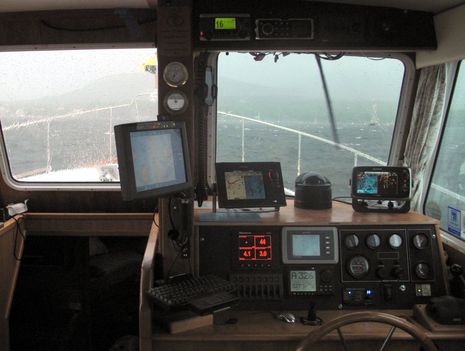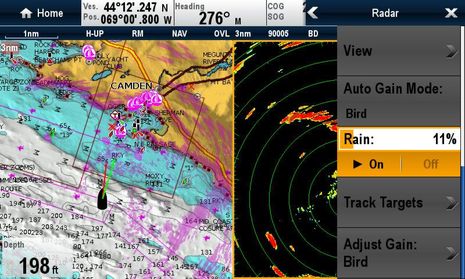Simrad NSS8 & Raymarine e7, with radar in the rain
The cool thing about this picture is that the potent storm cell generating all that wind and rain was just about to pass to the east and I’d managed to avoid almost all of it thanks to radar. After taking this shot I just ran up into Camden’s outer harbor and rigged fenders and docklines while Gizmo drifted sideways downwind; by the time I reached my float the evening sky had cleared and I tied up in calm conditions without foul weather gear…
Some might think that being out on the Bay was a little foolish in these conditions, especially by myself, but I’d already been underway with a WoodenBoat School navigation class the day before and was feeling good about Gizmo’s running gear. In fact, I’d learned that the boat has more speed at the top end without the weight of the generator and cabling I’d removed, and by the time I took the screenshot below I’d already used some that speed to get south of the storm cell’s track. (You can see this 6/22-23 trip on my inReach share map, though note that Chrome messes up the track connecting lines.)…
At any rate, I was quite impressed with how well the 18-inch Raymarine HD radome imaged that rain at 14 miles and how well the imagery could be seen and managed on the relatively small e7 display. I’d actually been able to see the squall line over 24 miles away, even with the Camden Hills in between, and that was a big strategic help. I’ve seen good rain tracking performance from this HD radar before — see the bottom of this 2009 radar comparison — but I was pleasantly surprised to see that its current retail price seems lower than it once was.
The combination of Simrad NSS8 and 4G Broadband radar also did the job, though not quite as well and with more effort involved. I was able to make out the same squalls at 24 miles plus but it took extra Gain and they still didn’t have the clear shape that the Ray HD got, as you can see above at 14 miles (though there may have been more I could do in terms of tweaking as I’m just getting familiar with 4G). In both cases the zoomed in chart overlay is using the same same long range imagery and thus is a little chunky, but both radomes are capable of dual range (though, as I saw last fall, the NSS can not take advantage of 4G’s amazing abilities in this area)…
As I almost left the whole rain cell to starboard, I tried the other aspect of radar in the rain, which is to filter it out so you can see what’s underneath. I prefer the on screen Rain, Sea, and Gain controls that Simrad uses with its rotary knob because they don’t obscure the results like that e7 menu does, but in fact they both worked fine. And I do like the presets Raymarine offers like the high-gain, low-filter (and fully customizable) “Bird” mode I was using to image those distant squalls. But then again the NSS plays a little nicer with the NSE above than the e7 does with the E Wide, though the later combo works better than you might think from the warnings in the e7 manual. More to come about their networking.
Overall, though, either one of these radar/MFD combinations would have been useful to have aboard in this situation. I failed to grab a screenshot of the NSS when I had the Rain clutter control up enough to knock it out better, but the shot below does show how I arrived home just about as last and most southerly rain cell was leaving and how I could have detoured a bit more left to miss it altogether. Good times and more coming!
















One thing you may notice in the NSS screen shots is that the 4G radar is not seeing well behind my boat. I think it’s a combination of factors, one being that the 4G is mounted in front of a flying bridge full of electronics as seen in the current header photo. The other factor is that Broadband seems to be more sensitive to such onboard obstructions, though the 4G at some ranges is seeing better aft than the 2G it replaced.
Great article Ben, just what I was looking for. Still makes the decision hard to make between the two. I think I’m leaning towards 4G for power efficiency and target clarity, but will once again put it all on hold until they release GoFree. I know its off the Radar topic here but have you heard anything more about GoFee?
Thanks Dean
Wow, this debunks a lot of the online scuttlebutt that says 4G can’t see rain cells. I’m surprised to realize just how useful it actually is. Awesome real world information, btw. Thank you!
…you seriously need a Furuno DRS Radar with NavNet (TZT is outstanding) on there. It’ll blow this away. The Radar has overlay Range Link and a true dual range radar, so even if you are zoomed in on overlay, yet zoomed out on Radar both images remain clear and relative.
Also, even though the 4G is good for broadband at range its still actually rather terrible at range. I am still yet to be sold on broadband. Every image I see is not that good. Especially in relation to their marketing.
Actually I do still have a Furuno DRS2D on Gizmo, though it’s not attached to anything right now as I returned the NN3D MFD12 and am awaiting a loaner TZtouch. Furuno radar, even this little one, is amazing, as I noted last year when I used it for rain detection:
https://panbo.com/archives/2011/07/furuno_drs2d_radome_punching_above_its_weight.html
But I think that the Raymarine RD418HD is just as good at rain detection, while costing substantially less, and the Navico 4G sets a new bar for dual range radar. The competition in radome performance is good for all of us and, while Garmin is a bit of laggard, who will be surprised if they come up with something hot?
Doppler would be nice, to see downbursts and windshear:
http://www.networkworld.com/community/blog/us-navy’s-high-resolution-radar-can-see-individual-raindrops-storm?t51hb
Impressive, but the satellite weather product is so much easier to use. I can replay a timed loop of Doppler images to understand the storm, freezing frames and making distance measurements.
Last Friday I snatched an extraordinary beautiful sunset sail from the clutches of an iffy forecast that kept most boats home, plus a sunset with two rainbows and a hat from the sailing club for completing the race others stayed home for.
Using the Raymarine SR100 I was able to track and confirm the accuracy of a specific prediction (2 hour prediction from weather.com) of a row of storm cells becoming disorganized 5 miles short of our race course.
With a backup plan at the ready (to run for a mooring field) we motored out of the harbor in weather so promising it didn’t occur to us to check email for a race cancellation.
Attached below is a message that went out to my sailing club from the person that cancelled the race (I didn’t receive the cancellation). From Fleet Captain: Lloyd Harbor racers: Though I made a last minute call to abandon this past Friday’s pursuit race based on a slow moving and seemingly powerful storm cell, one of our members did not receive the notice, successfully skirted the storms – and completed the course.
I was on Baycrest beach in Huntington Bay and did see Breeze Pleeze make her way around to the finish. And, though the race was without competition – it has been decided that Dan has earned his hat!
Simrad NSS Version 2 software is out and it’s full of enhancements:
http://www.simrad-yachting.com/en-US/Support/Downloads/NSS-Software/
I’ve been using it for a few weeks now and I’m enjoying improved 4G radar display, full Class B AIS static data display, StuctureMap overlays, Navionics user generated data, PDF viewing (the manuals are easy to load and browse), and more. Plus I think the NSS8 on Gizmo is now faster. And, though not stated on that page, NSS V2 includes the first NMEA 0183 level of Navico’s GoFree strategy. I haven’t gotten it working yet but I should be able to get the 0183 data available on the NSS to Gizmo’s WiFi router and then to iPad and smartphone apps like iNavX. More to come (especially as I’m now done with all the local activities that have kept me from Panbo work).
I have the e7 and e7d displays on my boat and one of the few things that I don’t like about them is that when adjusting the radar settings, you really don’t see what you are doing.
Fortunatley, the latest software update fixes this problem with new on-screen shortcuts for gain, rain and sea. If the screen-shots are anything to go by, this will allow us to do the adjustments without obscuring the radar screen at the same time.